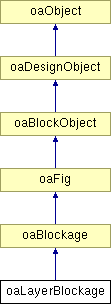 |
 |
 |
||||||
Inheritance diagram for oaLayerBlockage:

 |
 |
Public Methods | |
| oaLayerNum | getLayerNum () const |
| oaLayerHeader * | getLayerHeader () const |
| oaDist | getEffectiveWidth () const |
| oaBoolean | hasEffectiveWidth () const |
| oaDist | getSpacing () const |
| oaBoolean | hasSpacing () const |
| oaBoolean | allowPGNet () const |
| void | setLayerNum (oaLayerNum layerNum) |
| void | setPoints (const oaPointArray &points) |
| void | setEffectiveWidth (oaDist width) |
| void | unsetEffectiveWidth () |
| void | setSpacing (oaDist spacing) |
| void | unsetSpacing () |
| void | setAllowPGNet (oaBoolean allowPGNet) |
| void | transform (oaDouble scale, oaDouble angle) |
Static Public Methods | |
| oaLayerBlockage * | create (oaBlock *block, oaBlockageType type, oaLayerNum layer, const oaPointArray &points, oaBlockObject *owner=NULL) |
oaLayerBlockages may have an effective width. This is the value that is used by routing tools to determine the minimum spacing constraint for other geometry placed near the blockage. Typically, if a blockage has no effective width (hasEffectiveWidth() is false), the blockage should be treated as "real geometry" by tools, and its width is the width of the blockage plus any other adjacent geometry.
|
|
This function returns a boolean indicating whether shapes for power and ground nets are allowed within this blockage area.
|
|
||||||||||||||||||||||||
|
This is the constructor for a layer blockage.
|
|
|
This function returns the effective width of with this blockage. |
|
|
This function returns the layerHeader for the layer of this blockage. |
|
|
This function returns the layer number associated with this blockage. |
|
|
This function returns the spacing attribute on this blockage.
|
|
|
This function returns a boolean indicating whether or not an effective width has been set for this blockage. |
|
|
This function returns a boolean indicating whether or not the effective spacing attribute is set for this blockage.
|
|
|
This function sets the allowPGNet attribute for this blockage. When set, shapes for the signal types oacPowerSigType and oacGroundSigType are allowed within the blockage area.
|
|
|
This function sets the effective width of this blockage. The effective width value allows you to specify what width should be used when looking up the minimum spacing value in the technology database. Usage is as follows:
By default, blockage effective width is used to set spacing. oaLayerBlockage::setSpacing also can be used to set spacing. Note, however, that the spacing and effective width attributes are mutually exclusive. An attempt to set the effective width attribute on a blockage without first unsetting an existing spacing attribute throws an oacBlockageSpacingWidthExclusive exception.
|
|
|
This function moves this blockage to the specified layer. The new layer is created if it does not exist. The old layer is deleted if it becomes empty. A layer may not be set on placement blockages.
|
|
|
This function updates the shape of the blockages to the shape specified by the pointArray
|
|
|
This function sets the spacing attribute for this blockage. The spacing and effective width attributes are mutually exclusive. By default, the spacing attribute is unset, which means the blockage effective width is used to set spacing. An attempt to set the spacing attribute on a blockage, without first unsetting an existing effective width attribute, throws an oacBlockageSpacingWidthExclusive exception.
|
|
||||||||||||
|
This function transforms this blockage by the specified scale factor and rotation angle. If this blockage is a leader in a group, every object in the group is moved with the specified transform.
|
|
|
This function removes the effective width value for this blockage. |
|
|
This function unsets the spacing attribute for this blockage.
|

Copyright © 2002 - 2010 Cadence Design Systems, Inc.
All Rights Reserved.